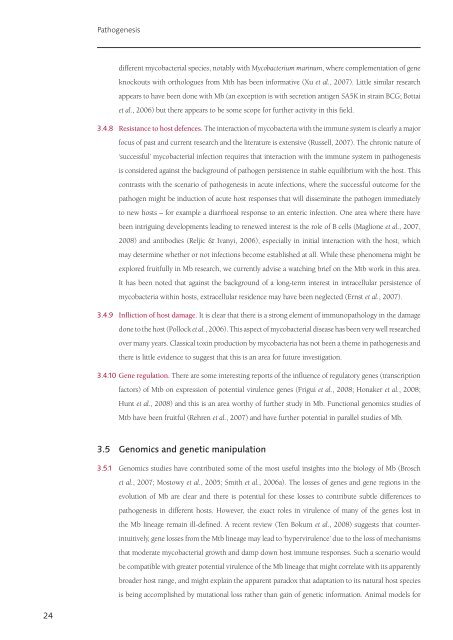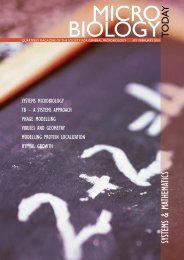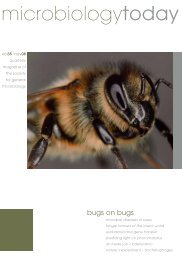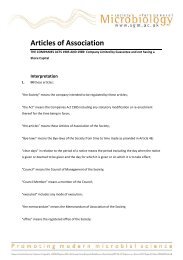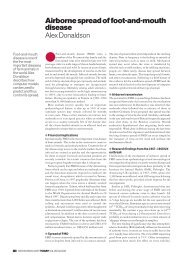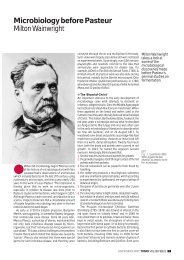final report - ARCHIVE: Defra
final report - ARCHIVE: Defra
final report - ARCHIVE: Defra
You also want an ePaper? Increase the reach of your titles
YUMPU automatically turns print PDFs into web optimized ePapers that Google loves.
Pathogenesis<br />
different mycobacterial species, notably with Mycobacterium marinum, where complementation of gene<br />
knockouts with orthologues from Mtb has been informative (Xu et al., 2007). Little similar research<br />
appears to have been done with Mb (an exception is with secretion antigen SA5K in strain BCG; Bottai<br />
et al., 2006) but there appears to be some scope for further activity in this field.<br />
3.4.8 Resistance to host defences. The interaction of mycobacteria with the immune system is clearly a major<br />
focus of past and current research and the literature is extensive (Russell, 2007). The chronic nature of<br />
‘successful’ mycobacterial infection requires that interaction with the immune system in pathogenesis<br />
is considered against the background of pathogen persistence in stable equilibrium with the host. This<br />
contrasts with the scenario of pathogenesis in acute infections, where the successful outcome for the<br />
pathogen might be induction of acute host responses that will disseminate the pathogen immediately<br />
to new hosts – for example a diarrhoeal response to an enteric infection. One area where there have<br />
been intriguing developments leading to renewed interest is the role of B cells (Maglione et al., 2007,<br />
2008) and antibodies (Reljic & Ivanyi, 2006), especially in initial interaction with the host, which<br />
may determine whether or not infections become established at all. While these phenomena might be<br />
explored fruitfully in Mb research, we currently advise a watching brief on the Mtb work in this area.<br />
It has been noted that against the background of a long-term interest in intracellular persistence of<br />
mycobacteria within hosts, extracellular residence may have been neglected (Ernst et al., 2007).<br />
3.4.9 Infliction of host damage. It is clear that there is a strong element of immunopathology in the damage<br />
done to the host (Pollock et al., 2006). This aspect of mycobacterial disease has been very well researched<br />
over many years. Classical toxin production by mycobacteria has not been a theme in pathogenesis and<br />
there is little evidence to suggest that this is an area for future investigation.<br />
3.4.10 Gene regulation. There are some interesting <strong>report</strong>s of the influence of regulatory genes (transcription<br />
factors) of Mtb on expression of potential virulence genes (Frigui et al., 2008; Honaker et al., 2008;<br />
Hunt et al., 2008) and this is an area worthy of further study in Mb. Functional genomics studies of<br />
Mtb have been fruitful (Rehren et al., 2007) and have further potential in parallel studies of Mb.<br />
3.5 Genomics and genetic manipulation<br />
3.5.1 Genomics studies have contributed some of the most useful insights into the biology of Mb (Brosch<br />
et al., 2007; Mostowy et al., 2005; Smith et al., 2006a). The losses of genes and gene regions in the<br />
evolution of Mb are clear and there is potential for these losses to contribute subtle differences to<br />
pathogenesis in different hosts. However, the exact roles in virulence of many of the genes lost in<br />
the Mb lineage remain ill-defined. A recent review (Ten Bokum et al., 2008) suggests that counterintuitively,<br />
gene losses from the Mtb lineage may lead to ‘hypervirulence’ due to the loss of mechanisms<br />
that moderate mycobacterial growth and damp down host immune responses. Such a scenario would<br />
be compatible with greater potential virulence of the Mb lineage that might correlate with its apparently<br />
broader host range, and might explain the apparent paradox that adaptation to its natural host species<br />
is being accomplished by mutational loss rather than gain of genetic information. Animal models for<br />
24


